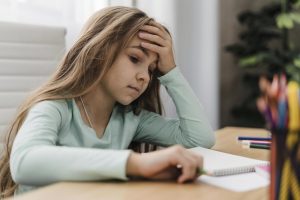 Many adults and children are working and learning remotely. This lack of face-to-face interaction can lead to feelings of boredom, isolation, and loneliness. An increased lack of structure can make it harder to accomplish tasks and can sometimes lead to anxiety or stress.
Many adults and children are working and learning remotely. This lack of face-to-face interaction can lead to feelings of boredom, isolation, and loneliness. An increased lack of structure can make it harder to accomplish tasks and can sometimes lead to anxiety or stress.
Navigating life from home can lead to major changes in daily routines. For instance, children with ADHD (Attention Deficit Hyperactivity Disorder) may have difficulty waking up and falling asleep at the same time when they don’t have to leave their home for school.
According to the National Sleep Foundation, low quality sleep can make ADHD symptoms more severe in children. In a recent study by Association for Child and Adolescent Mental Health, researchers also found that adolescents with ADHD experienced more depressive symptoms and exhibited negative behaviors when they got only 6 and a half hours of sleep.
Creating daily and weekly routines can help build good habits and may ease some ADHD symptoms. For example, according to Children and Adults with ADHD (CHADD), structure and routine can help reduce stress and uncertainty.
Creating a routine can include the following:
All of us need structure. For children with ADHD, however, it is absolutely essential. Children with ADHD tend to have more difficulty managing their behavior and staying on task when their schedule is uncertain. This is particularly true when they don’t know how long they will need to wait to do pleasurable activities.
A child’s physical space can profoundly impact their mental state. For instance, they may feel more focused when they do their work in a quiet, tidy room. Similarly, children may learn better without external distractions, such as noise from a television.
The following may help create a calming environment:
According to the authors of Effects of Exercise on Cognitive Performance in Children and Adolescents with ADHD, research suggests that regular physical activity leads to structural changes in the brain that may reduce ADHD symptoms in children such as improved impulse control and attention after a single 20-minute aerobic exercise session. Examples include bicycling, walking and running.
It is essential that children with ADHD continue their current treatment, which may consist of taking medication, attending behavioral therapy, or a combination of the two.
Contact with their healthcare providers is very important. and now many of them offer telehealth services, where they can perform health evaluations, consultations and psychotherapy sessions by video.
Children with ADHD can also benefit from staying connected with family and friends using video chat services. Talking to loved ones can help reduce feelings of isolation and loneliness. Try scheduling these calls ahead of time. It could help motivate a child to complete a project or task.
Excerpted from “COVID-19 Pandemic Holds Extra Challenges for Neurodivergent Individuals” in Network Health. Read the full post online.